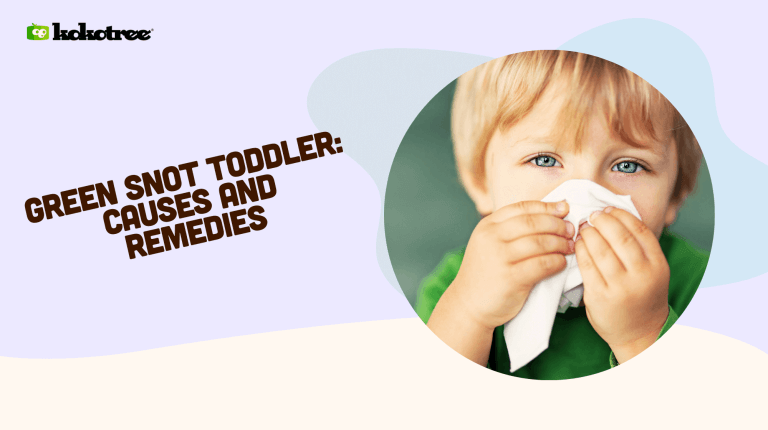

There’s nothing more worrisome than our little ones feeling under the weather, especially when their symptoms include a case of green snot or mucus. Let’s understand the causes behind your toddler’s green snot and explore some effective remedies to help alleviate their discomfort.
The main causes of green snot in toddlers are infections, such as the common cold or sinusitis, and allergies. This green color is due to the presence of white blood cells and enzymes that are fighting the infection or inflammation. Remedies to help alleviate your child’s symptoms include saline nasal sprays, maintaining proper hydration, using a humidifier, and ensuring adequate rest. Consult with a pediatrician if symptoms persist or worsen, as they can recommend appropriate care and, if necessary, medications.
When your toddler has a runny or stuffy nose with green mucus, it’s natural to be concerned. But understanding the causes can help address the issue effectively. Here’s an in-depth look into what might be causing that green snot:
Viral Infections: Often, green mucus in toddlers is a result of viral infections like the common cold or the flu. Initially, the mucus might be clear or whitish, but as the body sends white blood cells to combat the virus, these cells (neutrophils) can turn the mucus into a greenish hue.
Bacterial Infections: While viral infections are more common, bacterial infections like sinusitis or bronchitis can also lead to green snot. Unlike viral infections, bacterial infections might require antibiotics for treatment.
Environmental Allergens: Pollen, mold, dust mites, and pet dander are some of the common allergens that might trigger a green mucus response in toddlers. Seasonal changes often see a spike in such reactions, especially during spring and fall.
Food Allergies: While less common, certain food allergies can cause nasal congestion and green mucus. If you suspect a food allergy, it’s essential to consult with a pediatrician.
Irritants: External irritants like cigarette smoke, strong perfumes, cleaning agents, and polluted air can also lead to a green mucus response. Ensuring a clean, smoke-free environment and using hypoallergenic products can help mitigate this.
Sometimes, post-nasal drip or sinus drainage can result in green snot, especially if there’s a minor infection or irritation in the sinuses.
On rare occasions, toddlers, being the curious beings they are, might insert small items up their nose. This can cause an infection or irritate the nasal passages, leading to green mucus. If you suspect this, seek medical attention immediately.
Now that we know the common causes behind green snot in toddlers, let’s delve into some remedies to help alleviate their discomfort and support their overall toddler development.
Using a saline nasal spray can help to clear your toddler’s congested nose by thinning mucus and reducing inflammation. It’s simple to use and provides quick relief. Look for a saline spray that’s specially designed for children, as adult versions may be too strong.
Keeping your child well-hydrated can help to thin the mucus and make it easier for them to clear their nasal passages. Encourage frequent sips of water, and offer warm decaffeinated teas or soup, as warm liquids can also help to soothe a sore throat and reduce mucus production.
Incorporating steam into your toddler’s daily routine can effectively relieve congestion. Running a warm bath or shower and allowing your toddler to breathe in the steam can help to loosen mucus. Alternatively, using a humidifier in your child’s room can also help to maintain a moist environment, making it easier for them to breathe comfortably.
When a toddler is lying down, mucus can accumulate and worsen congestion. To alleviate this, try placing a pillow or towel beneath the mattress to slightly elevate your child’s head while they sleep. This can help to prevent mucus buildup and promote better rest.
Teaching your toddler to gently blow their nose or wipe it using soft tissues can help them to clear the nasal passages and reduce the chances of infection spreading. Make sure to encourage handwashing after nose blowing or wiping to minimize germ transmission.
It can be challenging to focus on your child’s overall development when they’re feeling under the weather. However, these tips can help support their learning and growth during this time:
Even when sick, listening to stories or being read to can be a comforting and educational experience for your toddler. Read their favorite books or create a story to capture their imagination and take their mind off their symptoms for a bit.
Select a learning app for toddlers that combines learning with fun. This can provide entertainment, while also helping them to practice their cognitive and motor skills. Look for age-appropriate apps, such as those focused on early reading skills or simple puzzles.
Engaging in gentle, indoor activities can help your toddler to burn off energy without overexerting themselves. Try setting up a quiet play area with coloring books, puzzles, or blocks, and encourage them to explore their creativity and problem-solving abilities.
While green snot often resolves itself within a week, it’s crucial to keep an eye on your toddler’s symptoms, as in some cases, medical intervention may be necessary. Consider consulting a pediatrician if:
If your child’s symptoms last longer than a week, or if their condition suddenly deteriorates, it’s essential to seek professional medical advice to identify and address any underlying problems.
A high fever might indicate a more severe infection or a different underlying cause. If your toddler has a persistent fever above 100.4°F (38°C) for more than a few days, consult your pediatrician for further guidance.
If your child is experiencing severe coughing or difficulty breathing, it’s important to seek immediate medical attention, as this could be a sign of a more serious respiratory issue.
If your toddler experiences frequent bouts of green snot, it may point to an underlying issue, such as persistent allergies, structural abnormalities in the nose, or a weakened immune system. In these cases, it’s essential to work with a healthcare professional to identify and address the root cause.
Armed with the knowledge of the causes behind green snot in toddlers and an arsenal of handy remedies, you’ll be well-equipped to take care of your little one while they’re feeling under the weather. Focus on providing comfort and maintaining a positive environment, and soon enough, your toddler will be back on track with their development journey!
While it’s not possible to completely prevent your toddler from catching infections, there are steps you can take to strengthen their immune system and reduce the frequency and severity of illnesses:
Providing your child with a well-balanced diet, rich in fruits, vegetables, whole grains, and lean proteins, can help to support their immune system. Foods rich in vitamins A, C, and E, as well as zinc and selenium, provide essential nutrients that contribute to a healthy immune response.
Ensuring your child gets enough sleep is crucial for their overall health and wellness, as well as for supporting their immune system. Establish a consistent bedtime routine and create a sleep-friendly environment to promote restful and rejuvenating sleep.
Physical activity and playtime are critical components of toddler education and development. They also help to strengthen your child’s immune system. Encourage activities such as dancing, jumping, and outdoor play to promote a healthy, active lifestyle.
Teaching your toddler to wash their hands regularly is one of the most effective ways to prevent the spread of germs and reduce the risk of illness. Make handwashing a fun and educational activity by using songs, timers, or colorful soaps to keep your child engaged.
As parents, we are always looking for ways to support our child’s education and growth. Here are a few more tips to help you in this journey:
Select toys and games that encourage your toddler’s cognitive and social development. Look for options that engage their curiosity and creativity, such as building blocks, musical instruments, or pretend-play sets.
Seize the opportunity to turn everyday situations into teachable moments, whether it’s counting the steps as you walk or identifying colors and shapes in the environment. This real-world learning approach can help make toddler education enjoyable and more accessible.
Participate in group activities or introduce your child to other toddlers, giving them the opportunity to develop social skills, learn empathy, and build lasting friendships. Libraries, community centers, and playgrounds are great places to engage in social experiences.
By paying close attention to your toddler’s overall health and well-being, and providing them with opportunities to learn and grow, you’ll help them establish a solid foundation for a lifetime of healthy habits and happy learning experiences.
If you still have questions about green snot, toddler health, or education, don’t worry! We’ve compiled a list of common questions and their answers to help ease your concerns and provide more clarity on the topic.
Green snot is typically caused by an infection or inflammation, which results from the presence of white blood cells and enzymes fighting the issue. This color change indicates your child’s immune system is at work.
Not necessarily. Green snot can occur due to viral infections like the common cold, flu, or other bacterial infections such as sinusitis. It can also be a sign of allergies or exposure to irritants.
Yes, allergies can cause green snot in toddlers. Allergies trigger the body’s immune response, which may result in green mucus production. Identifying and reducing exposure to any allergens can help alleviate symptoms.
If your toddler’s symptoms last longer than a week, worsen, or are accompanied by a high fever, excessive coughing, or trouble breathing, seek professional medical advice promptly.
Over-the-counter medications may not always be suitable for young children. Consult with a pediatrician before administering any medication to ensure it is safe and age-appropriate for your toddler.
To prevent the spread of germs, teach your child to gently blow or wipe their nose with soft tissues and wash their hands immediately afterward. Frequent cleaning of commonly touched surfaces and toys can also help reduce the spread of germs.
Yes, focusing on age-appropriate activities, such as reading or storytelling, and utilizing educational apps for toddlers, can provide entertainment while keeping your child engaged in learning during illness.
Offering a nutritious diet, ensuring sufficient sleep, encouraging regular exercise and play, and teaching good handwashing habits can all contribute to strengthening your toddler’s immune system.
While symptoms may sometimes overlap, allergies often cause itching or watery eyes and may improve when the allergen is removed. Cold symptoms, on the other hand, may include a sore throat, cough, or fever. Consult a pediatrician for a proper evaluation and diagnosis.
Yes, using a humidifier can help maintain a moist environment in your child’s room, making it easier for them to breathe comfortably and helping to relieve congestion.
No, adult saline nasal sprays may be too strong for young children. Look for a saline spray that is designed specifically for toddlers or children to ensure its safety and effectiveness.
In some cases, green snot may be a sign of a more serious underlying problem. Always consult a pediatrician if symptoms worsen, persist for an extended period, or are accompanied by high fever or difficulty breathing.
Offer comfort, affection, and reassurance during your child’s illness. Utilize remedies such as saline nasal sprays, hydration, warm drinks, steam, and elevating the head while sleeping to help alleviate their symptoms and discomfort.




